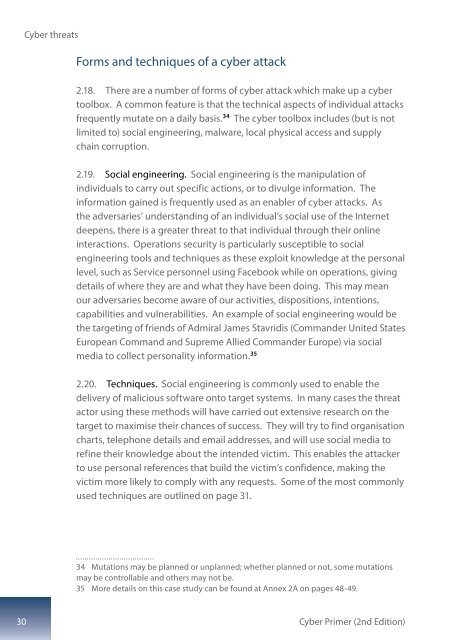Cyber Primer
AEWhbF
AEWhbF
You also want an ePaper? Increase the reach of your titles
YUMPU automatically turns print PDFs into web optimized ePapers that Google loves.
<strong>Cyber</strong> threats<br />
Forms and techniques of a cyber attack<br />
2.18. There are a number of forms of cyber attack which make up a cyber<br />
toolbox. A common feature is that the technical aspects of individual attacks<br />
frequently mutate on a daily basis. 34 The cyber toolbox includes (but is not<br />
limited to) social engineering, malware, local physical access and supply<br />
chain corruption.<br />
2.19. Social engineering. Social engineering is the manipulation of<br />
individuals to carry out specific actions, or to divulge information. The<br />
information gained is frequently used as an enabler of cyber attacks. As<br />
the adversaries’ understanding of an individual’s social use of the Internet<br />
deepens, there is a greater threat to that individual through their online<br />
interactions. Operations security is particularly susceptible to social<br />
engineering tools and techniques as these exploit knowledge at the personal<br />
level, such as Service personnel using Facebook while on operations, giving<br />
details of where they are and what they have been doing. This may mean<br />
our adversaries become aware of our activities, dispositions, intentions,<br />
capabilities and vulnerabilities. An example of social engineering would be<br />
the targeting of friends of Admiral James Stavridis (Commander United States<br />
European Command and Supreme Allied Commander Europe) via social<br />
media to collect personality information. 35<br />
2.20. Techniques. Social engineering is commonly used to enable the<br />
delivery of malicious software onto target systems. In many cases the threat<br />
actor using these methods will have carried out extensive research on the<br />
target to maximise their chances of success. They will try to find organisation<br />
charts, telephone details and email addresses, and will use social media to<br />
refine their knowledge about the intended victim. This enables the attacker<br />
to use personal references that build the victim’s confidence, making the<br />
victim more likely to comply with any requests. Some of the most commonly<br />
used techniques are outlined on page 31.<br />
34 Mutations may be planned or unplanned; whether planned or not, some mutations<br />
may be controllable and others may not be.<br />
35 More details on this case study can be found at Annex 2A on pages 48-49.<br />
30<br />
<strong>Cyber</strong> <strong>Primer</strong> (2nd Edition)


